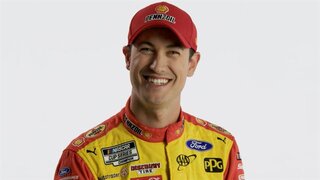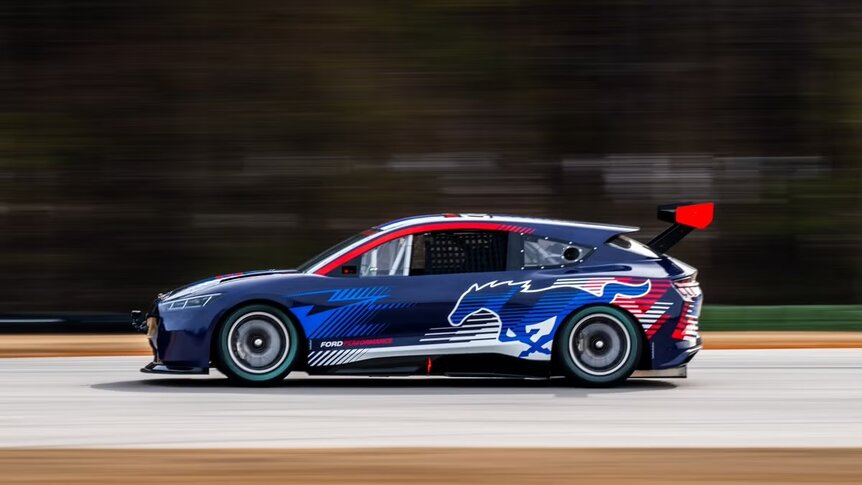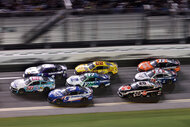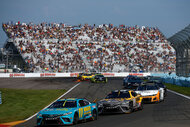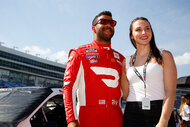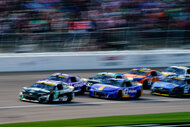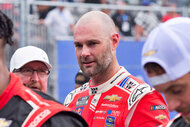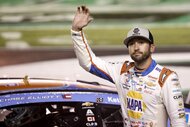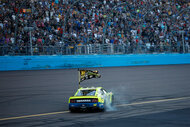Is This the Future of NASCAR? Ford's Mustang Mach-E Prototype Hits the Track
Harnessing electric horsepower is part of NASCASR’s broader strategy to achieve net-zero emissions by 2035.
Eponymously founded more than a century ago in 1903 by its legendary pioneer, the Ford Motor Company has been a pinnacle of the American automotive industry since its inception and a key player in the ongoing success of NASCAR. Now, as the league transitions its high-octane events toward a greener future, Ford is leading the charge to help NASCAR achieve its goal of decarbonizing motorsports by 2035 with its latest turbo chariot – the Ford Mustang Mach-E NASCAR Prototype.
The automaker unveiled its latest example of boundary-pushing innovation this past weekend at the NASCAR All-Star race in North Wilkesboro, North Carolina – a fitting venue, considering it was the first and original track in the league. With veteran Cup Series driver David Ragan behind the wheel, Ford’s prototype electric sled dazzled fans and pundits alike as it made its debut on the 0.625-mile oval. From dusting a couple laps to showcasing its “launch mode” out of a standstill start, Ragan finished his fast and furious demonstration down the front stretch with the time-honored tradition that’s a must for any racecar – the signature burnout.
“It was really a quick test session for this Ford Mach-E NASCAR Prototype,” noted Ragan, per Speedway Digest. “The first time here at North Wilkesboro Speedway and this thing has over 1000 horsepower, so it’s incredible the amount of power that this car has.”
A closer look at Ford's Mustang Mach-E NASCAR Prototype
Constructed with the same chassis and safety components as the current NASCAR Cup Series Mustang that championship-winning drivers Joey Logano and Ryan Blaney both pilot, the Ford Mach-E NASCAR Prototype is equipped with three motors – one in the front and two in the rear – and is capable of topping out at a whopping 1,360 horsepower. For comparison, according to Road & Track, that’s nearly double the stallions of Ford’s current offering in the Cup Series, the Mustang Dark Horse.
But the company’s latest prototype is far from just about speed – it’s about sustainability. During his spin around the track, Ragan also displayed the Mach-E’s regenerative braking feature, which is a critical element to electric cars. As the vehicle slows down, Ford’s prototype can convert some of its kinetic energy into electric energy that then recharges its batteries. Road courses like Chicago, whose myriad of turns naturally forces drivers to slow down, would see the greatest benefit from this feature.
“It stops really well,” Ragan added. “I was trying to get a good burnout at the end without shredding the tires all the way, so that was fun.”
When comparing the Mach-E to the current Next Gen Cup car, Ragan pointed out multiple shared commonalities between the two vehicles as well as the most noticeable differences between them.
“The cars really drive similarly in the middle of the corner,” opined Ragan. “This is the same chassis that the current Cup cars are running with in the Next Gen race car, so the steering, the side force, the handling feels very similar. ... Where the Mach-E just outperforms the other car is that pure acceleration. The amount of torque that it has is incredible, and it’s instant torque because being an all-wheel drive car, you’ve got a lot of torque when you’re on the throttle.”
One realm that NASCAR is infamously known for is noise, sometimes eclipsing up to 130 decibels. As exhilarating as the cumulative roar of 40 race cars is to experience in person, there’s a reason why it’s advised to always throw a couple ear plugs in your bag on race day. Ford’s Mustang Mach-E protype could potentially revolutionize that element of NASCAR races, opening up in-person races to entirely new factions of race fans who’ve only kept their distance due to the auditory toll their ears would endure at a race.
“When you hit the brakes, it stops on a dime and it’s quiet,” he continued. “I can hear myself thinking, and it’s really weird to hear some of the rubber banging off the inside of the car. You can hear the tires squealing a little bit, so you don’t have that loud noise to drown yourself out.”
While 1964 was the first year in which a Ford Mustang appeared on a racetrack, per CNET, the brand’s revered model made its NASCAR racing debut during the Monster Energy Cup’s 2019 Daytona 500 as a result of engineering collaboration between the league and Ford’s performance and design teams.
